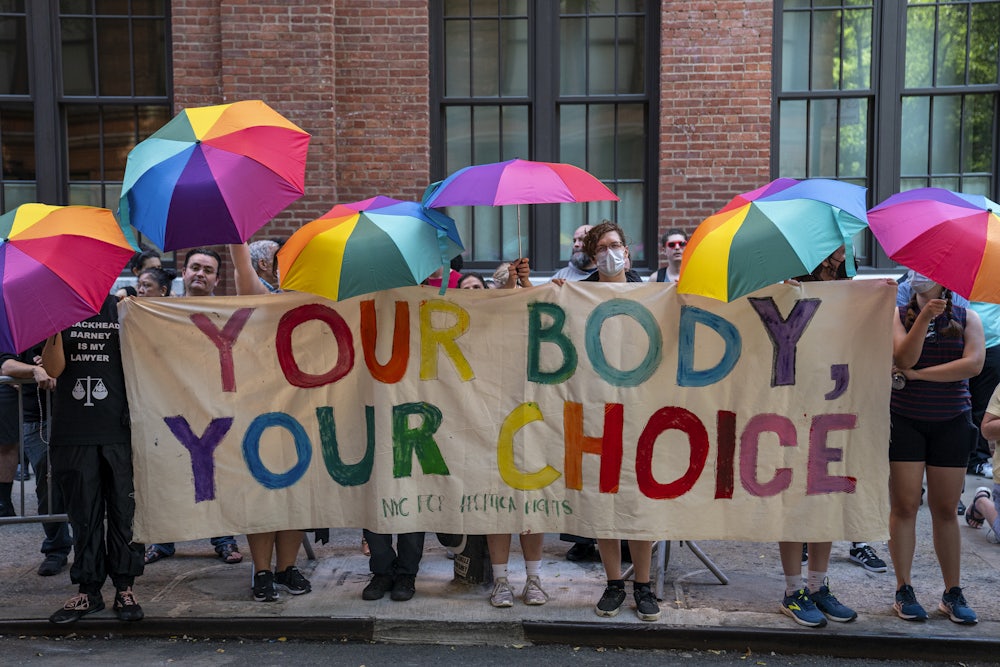The night Texas’s six-week abortion ban, Senate Bill 8, went into effect just over a year ago, abortion providers at the Whole Woman’s Health network of abortion clinics saw patients until 11:56 p.m.: four minutes before providing most abortions became a crime in their state; nearly a year before Roe v. Wade would be overturned. Mikayla Dawson was tweeting through it.
Dawson had been the social media specialist at Whole Woman’s Health for less than a year when S.B. 8 went into effect, and in the days leading up to its implementation and the aftermath that followed, her job was quite literally to bear witness to it. On Twitter, she shared information on how Texans could still access abortion, discussed the disproportionate impact anti-abortion laws have on marginalized communities, and even subverted outdated talking points on abortion. (“Abortions don’t need to be made ‘rare’ because there is nothing wrong with abortion,” read one tweet.)
These messages don’t read as polished middle-of-the-road pro-choice slogans but as a raw record of a frightening, upsetting time, written in a voice tinged with compassion, rage, and authentic concern. Dawson, and activists like her, believe that this is something abortion funds and activists in states that have banned or placed severe restrictions on abortion are uniquely positioned to do. “We’re not tweeting at these people, we’re tweeting with these people,” she told me. “We’re really in that voice and really amongst their community. And I think it’s just a tone from this movement that people are not used to.”
It resonated. Dawson estimates she sent about 10 tweets an hour the first day S.B. 8 was in effect and saw the follower count for Whole Woman’s Health nearly double. “It was tragically S.B. 8 that made those accounts take off,” she said.
Dawson no longer works for Whole Woman’s Health—she’s moved on to another organization in the reproductive health policy space–but her experience with the group epitomizes a move among reproductive rights organizers at abortion funds and independent clinics to experiment with new ways of reaching audiences, mobilize social media as a place for meaningful activism, and capture paradigm shifts on abortion as they happen—all with significantly fewer resources and less guaranteed exposure than leading national reproductive rights advocacy groups, such as Planned Parenthood.
Like Dawson, Makayla Montoya Frazier, founder of Buckle Bunnies Fund, one of the few Texas abortion funds still in operation since Roe was overturned, also noticed a doubling effect from S.B. 8 on her fund’s Twitter following, and she’s found the social media platform to be a useful way to connect Texans seeking abortions with resources. “The asks that we have for people are sometimes just so big, and I feel bad doing it through somewhere that’s as inauthentic as Twitter dot com,” she said. “But that’s just what we have to do right now.”
The group uses Twitter because it works. After S.B. 8, Buckle Bunnies needed a volunteer to drive a client seven hours from Houston to Louisiana so that they could get an abortion, she said. Montoya Frazier found that volunteer via Twitter.
But even when abortion is all over the news, that isn’t necessarily reflected in abortion funds’ and independent clinics’ ability to reach people online—especially on social media, where platform policies can disrupt organizing efforts.
In the wake of Roe’s reversal, people flocked to social media to share details about how to find and use abortion pills, which can be a safe and effective way to self-manage abortion and, crucially, are available by mail and telemedicine in some states. But Facebook and Instagram quickly removed posts proposing help procuring the pills. A reporter from the Associated Press found it was easier to offer a gun on Facebook than abortion pills. Accounts have been impacted as recently as the end of August, when Jezebel reported that the Instagram account for Plan C, which shares information on how to safely use abortion pills but doesn’t distribute them, had been suspended by the platform for violating community guidelines. (Facebook did not respond to requests for comment for this story.)
In July, Senators Amy Klobuchar and Elizabeth Warren called on Facebook and Instagram to address this pattern of removing posts related to abortion. “Reports indicate that multiple posts providing accurate information about how to legally access abortion services were removed, often within minutes after the information was posted,” the senators wrote in a letter to Mark Zuckerberg and head of Instagram Adam Mosseri requesting that the company share, among other information, how it planned to prevent posts about abortion from being taken down erroneously. Klobuchar and Warren also expressed concern over posts about abortion being “tagged with ‘sensitivity screens’ and warnings,” something I encountered on Twitter when, after the Dobbs decision, I tried to share my own reporting on abortion policy and found a screenshot from one of my stories hidden behind a “sensitive content” warning.
But clinics and funds report even more deep-seated problems than this, extending back to the time before Roe was overturned and impacting even seemingly banal social media posts. “I would say since late 2020 [and] early 2021 anything around abortion, sex, or reproductive or sexual health was clearly impacted,” said Mercedes Sanchez, director of development, communications, and community education and outreach at Washington state’s Cedar River Clinics, which has provided abortion care to Texans since S.B. 8 went into effect and routinely serves patients from nearby Idaho. “I remember I tried posting about the health benefits of masturbating from a health outlet and they blocked it for inappropriate content.”
When platforms like Facebook remove posts, it’s often difficult to find out why—they’ll often simply cite the company’s community guidelines, activists say. When an ad is rejected, platforms will usually give a more detailed explanation, but the ad can only be reinstated through an appeals process activists often don’t have the resources to pursue. Dawson encountered this at Whole Woman’s Health, when a post about accessing abortion pills, from a clinic offering them in what was obviously a medical setting, was flagged on Facebook for “medical misinformation.” While larger organizations might have the resources and inroads at Facebook to appeal a decision like this one, that’s not the same for smaller groups like abortion funds. “It’s literally just you trying to go up against this big, giant platform,” Dawson said, “and [you don’t] understand why your posts aren’t getting seen or why your ad got rejected or why your post is being taken down because you tried to fundraise for somebody’s abortion.”
It’s one thing to deal with an ad being rejected; it’s another level of challenge when it just seems like posts aren’t being seen for unclear reasons, raising questions about whether accounts have experienced what’s known as “shadow-banning,” when a platform’s algorithm deprioritizes certain types of content without notifying their creators. Mosseri, the head of Instagram, has denied the existence of shadow-banning, though its parent company Facebook has a patent for something that sounds a lot like shadow-banning.
This leaves abortion clinics and funds with few tools to determine whether an account has been deprioritized. It’s “more feeling than conjecture,” said Cedar River Clinics’ Sanchez, who suspects some of her organization’s social media posts have been deprioritized on apps like Facebook and Instagram. It’s easier to identify a pattern of limiting posts related to abortion in the clinics’ attempts to purchase advertising space on the platform. During a period of about six months in 2021, Sanchez said, Facebook had rejected ads related to abortion “if there was any hint of a political message.”
Since the Supreme Court overturned Roe in June, Sanchez estimates that Cedar River’s reach on Facebook is between 50 to 75 percent lower than it used to be, a dissonant development given renewed interest in abortion policy in recent months. (For comparison, less overtly politicized digital spaces have seen the opposite effect: In August, The New York Times reported that digital media publications geared toward female readers, including Jezebel and The Cut, had seen a major influx of traffic after the Roe reversal.)
Even when small grassroots organizations do find their audiences online, it isn’t always easy to corral that energy and desire to help. For Buckle Bunnies, the surge in followers that came after S.B. 8 was exciting, but it also created more work for a small fund staffed by volunteers. After S.B. 8 and the reversal of Roe, said Montoya Frazier, people reached out to the group almost as a way to self-regulate or seek relief, without much understanding of the day-to-day challenges of funding abortion in a state hostile to reproductive rights, where the threat of prosecution has disrupted the work of abortion clinics and funds. “They wanted to feel special in that moment, like, ‘I can do this, I can do this,’” Montoya Frazier said. “And I’m like, ‘No, you can’t. You can’t just do this out of the blue. You can’t provide for abortion seekers in a criminalized state out of the blue with no experience because you want to feel good. And I can’t help you do that either, because I’m trying to help people in a criminalized state get abortions.’”
But when social media works, it really works. Dawson and Montoya Frazier met on Twitter; the reproductive health advocacy world is small. And if their day-to-day exchanges with supporters online reflect the messiness of the current moment since S.B. 8 and the reversal of Roe, they also reveal a way forward. “I do genuinely believe that the culture change that we need to stop these abortion bans, it lies in social media,” Dawson said. “I mean, that’s really our only pipeline to the public. And if we take it really seriously—and we are—we can really count on a culture change around abortion sooner than we think.”


